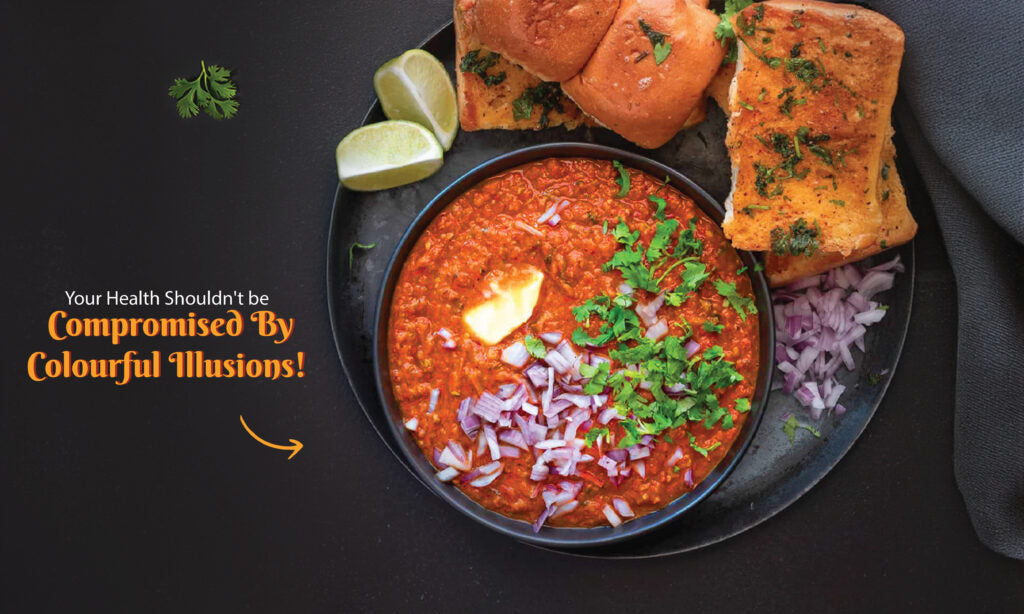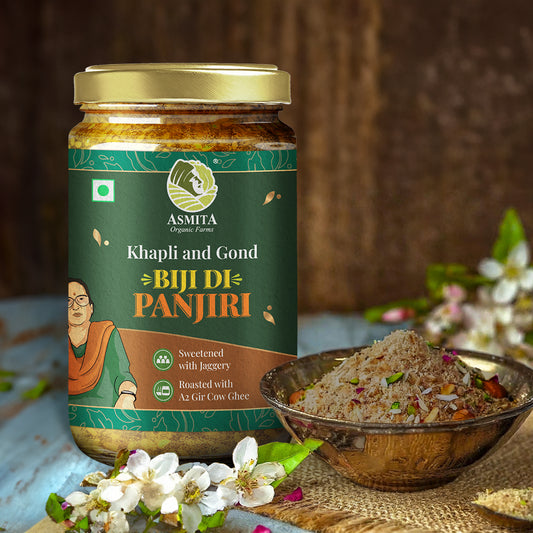7 Harmful Effects Of Artificial Food Colouring
Info Organic 5 min read
Ever grabbed a bag of colourful candies or a vibrant soda and wondered just how those bright hues came to be? Many of us love the rainbow of colours in our food and drinks, whether it's the cheerful orange of a cheese puff or the deep blue of a sugary drink. But did you know that behind those appealing shades might lurk some hidden dangers?
Artificial food colours are found in many processed foods and drinks we consume daily. From breakfast cereals to snack bars and even tempting desserts, synthetic colours are used to make our food look more attractive.
While they might make our meals visually appealing, the truth is that these food dyes can have some not-so-pretty effects on our health.
Parents often buy colourful snacks for their kids, thinking they’re just harmless treats. However, research has shown that these synthetic colours can lead to a variety of health issues.
Not just for kids but adults too can experience adverse effects from consuming too much artificial food. There are plenty of food colour side effects which we are unaware of. Read till the end to find out more about the harmful effects of artificial food colours on your health.
Table Of Contents:
- What is Food colouring?
- Types of Food Colouring
- Rising Trends of Artificial Colours
- What Types of Artificial Dye Colours are Approved by the FDA?
- Side Effects of Artificial Food Colouring
- Preventive Measures of Artificial Food Colouring
- Conclusion
- FAQs
What is Food coloring?
Food colouring is what makes our food look fun and appealing. Imagine a birthday cake without bright frosting or candies that are all the same colour, sounds boring, right? That's where food colouring comes in. It adds visual excitement to what we eat and drink.
Food colouring can be natural or artificial. Natural food colours are made from real ingredients like fruits, vegetables, and spices. For instance, the red in strawberry jam comes from strawberries, and the green in some mint candies might come from spinach or parsley.
On the other hand, artificial food colours are created in labs. These synthetic colours are designed to be more vibrant and stable than natural ones, but the harmful colours present in these foods can even cause cancer. They can make food look more uniform and appealing, which is why they're used in many processed foods like cereals, sodas, and snack bars.
Food colouring isn’t just about looks, though. It can also affect our perception of taste. Studies have shown that people often think a more vividly coloured food tastes better than a dull-looking one, even if the flavour is exactly the same. This is why companies put so much effort into perfecting the colour of their products.
Types of Food Colouring
Artificial colouring in food comes in many types, each adding a splash of colour to our meals and treats. Understanding these types of artificial colouring in food can help us make better choices about what we eat. Let’s explore the different kinds of food colouring available.
1. Natural Food Colouring
Natural food colouring is derived from plants, animals, and minerals. These colours are extracted from natural sources and are often considered safer and healthier options.
- Vegetable-Based Dyes: These include colours extracted from vegetables and fruits. For instance, beet juice gives a rich red colour, spinach provides green, and turmeric offers a bright yellow. These dyes are commonly used in organic and health-conscious products.
- Animal-Based Dyes: Some natural colours come from animals. A well-known example is cochineal, a red dye made from crushed cochineal insects. This dye is often used in cosmetics and some food products.
- Mineral-Based Dyes: Minerals like titanium dioxide can be used to create white food colouring. This type is often found in products like icing and confectionery.
2. Artificial Food Colouring
Artificial colouring in food is made from chemicals in laboratories. These synthetic colours are designed to be more vibrant and stable than natural colours, making them popular in many processed foods.
- Certified Colours: In many countries, artificial food colours are regulated and certified for safety. In the United States, the FDA approves certain synthetic colours, like Red 40, Yellow 5, and Blue 1. These are used in a wide range of foods, from candies to soft drinks.
- Lakes: These are a type of synthetic colour that is made by combining dyes with salts to make them insoluble in water. Lakes are used in products where moisture is a concern, like coated tablets and dry mixes.
3. Specialty Food Colouring
Some food colouring types are created for specific uses or effects.
- Neon Colours: These are artificial colours made to produce bright, neon-like shades. They are often used in novelty candies and party foods.
- Pearlescent Colours: These food dyes are used to give a shimmery, metallic finish to foods. Common in cake decorating, they can make baked goods look extra special.
- Glow-in-the-Dark Colours: Though not as common, some food products use special dyes that glow under black light. These are usually found in party settings or themed events.
Rising Trends of Artificial Colours
Artificial colouring in food has become a significant part of the food and beverage industry, with trends highlighting their increasing use and evolving consumer preferences. Let’s explore these rising trends and understand how artificial food colours are shaping the way we eat and drink.
Vibrant Visual Appeal:
One of the most noticeable trends is the growing demand for visually striking foods and drinks. Bright, bold colours make products more appealing, especially to younger consumers and children.
From neon-coloured energy drinks to rainbow-hued candies, synthetic colours are used to create eye-catching products that stand out on store shelves. Did you know that the famous Blue Raspberry flavour wouldn't exist without artificial food colouring? There's no such thing as a blue raspberry in nature!
Instagram-Worthy Foods:
Social media platforms like Instagram and TikTok have played a significant role in popularising vibrant, colourful foods. People love sharing pictures of visually stunning meals, and artificial food colours help achieve those photogenic looks.
Unicorn lattes, galaxy doughnuts, and mermaid-inspired treats are just a few examples of how synthetic colours are used to create share-worthy content. This trend has given rise to some incredibly creative and unexpected food and drink combinations, all thanks to artificial food colour dyes.
Convenience and Processed Foods:
The rise of convenience and processed foods has also contributed to the increased use of artificial food colours. Ready-to-eat meals, snack foods, and packaged drinks often contain synthetic colours to enhance their visual appeal and shelf life. These foods are designed to be visually appealing and easy to consume, making them popular choices for busy lifestyles.
Interestingly, some cereals owe their vibrant hues to artificial food dyes, which helps them look more appealing to both kids and adults during those rushed morning routines.
Speciality and Themed Products:
Another trend is the use of artificial colours in speciality and themed products. During holidays and special occasions, food manufacturers release limited-edition items with festive colours.
Think of red and green candies during Christmas, pastel-coloured treats for Easter, or spooky black and orange snacks for Halloween. These themed products rely heavily on synthetic colours to capture the spirit of the season.
It’s fascinating how these colours can evoke such strong festive feelings, making holidays even more enjoyable.
Health and Wellness Influence:
While there is a rising trend in the use of artificial colouring in food, there is also a growing awareness of their potential harmful effects.
As more consumers become health-conscious, some are opting for products with natural colours or no added colours at all. This has led to a dual trend: while brightly coloured, synthetic-dye-laden products remain popular, there is also a surge in demand for cleaner labels and naturally coloured alternatives.
For instance, some companies now use beetroot juice instead of Red 40 for a natural red hue, catering to the health-conscious market.
Regulatory Changes:
Around the world, regulations regarding artificial food colours are evolving. In some regions, stricter laws are being implemented to control the use of synthetic colours in food and drink.
For example, in Europe, certain artificial dyes require warning labels due to potential health risks. This has influenced some companies to reduce or eliminate these dyes from their products to comply with regulations and meet consumer expectations.
What Types of Artificial Dye Colours are Approved by the FDA?
Artificial food dyes make our favourite foods and drinks look attractive. The U.S. Food and Drug Administration (FDA) regulates these dyes to ensure they are safe for consumption. Let's examine the types of artificial dye colours approved by the FDA and how they impact the food we eat, especially for Indian consumers who love vibrant, colourful treats.
FD&C Colours
The FDA approves several synthetic colours in food, known as FD&C (Food, Drugs, and Cosmetics) colours, for use in food products. These dyes undergo rigorous testing to ensure they are safe to eat. Here are some common FDA-approved artificial colours:
- Red 40 (Allura Red AC): Red 40 is widely used in the United States and is found in candies, cereals, beverages, and desserts. Its vibrant red hue is popular in many processed foods. Interestingly, while this dye is approved by the FDA, it's often used in similar products found in Indian markets, especially during festive seasons when sweets are in high demand.
- Yellow 5 (Tartrazine): Known for its bright yellow colour, Yellow 5 is found in soft drinks, candies, chips, and baked goods. It’s also present in some medications and cosmetics. This dye is quite common in India, especially in snacks like namkeens and popular soft drinks.
- Yellow 6 (Sunset Yellow FCF): This dye provides an orange-yellow colour and is used in snack foods, cereals, beverages, and ice creams. In India, you might see this dye in packaged sweets and bright orange-flavoured drinks.
- Blue 1 (Brilliant Blue FCF): Blue 1 gives a bright blue colour to products like candies, ice creams, and beverages. This dye is particularly appealing in party snacks and ice lollies that are popular among kids in India.
Why It Matters?
The FDA requires extensive testing before approving any artificial dye for use in food, ensuring these dyes do not pose significant health risks when consumed within regulated limits. However, it’s important to note that the use of these dyes can vary globally. For example, while the FDA approves these dyes, some countries, including parts of Europe, have stricter regulations and require warning labels on products containing certain artificial colours.
For Indian consumers, this means being aware of what’s in the colourful snacks and drinks we love. The vibrant colours that make our foods so appealing also mean that they contain synthetic dyes. While the FDA-approved dyes are considered safe, some people may prefer to avoid them due to potential allergic reactions or health concerns.
Side Effects of Artificial Food Colouring
Artificial food colouring makes food look appealing, but it can also have some unwanted side effects. Synthetic colours are commonly found in processed foods and drinks, and understanding their potential impact on our health is essential, especially for Indian consumers who enjoy vibrant, colourful treats. Here are some of the harmful effects of artificial food colours:
Allergic Reactions: One common side effect of artificial food colouring is allergic reactions. Some people may be sensitive to certain food dyes, experiencing symptoms like hives, itching, and swelling. For instance, Tartrazine (Yellow No. 5), widely used in Indian snacks and sweets, can cause such reactions in a small percentage of people. If you've ever felt a bit itchy after enjoying your favourite bright yellow namkeen, it could be due to this dye.
Hyperactivity in Children: There has been considerable debate about the impact of artificial food colouring on children's behaviour. Studies suggest that certain synthetic colours in food may contribute to hyperactivity and attention issues in children. For example, Red No. 40 and Yellow No. 6, commonly found in candies and festive sweets in India, have been associated with increased hyperactivity and reduced attention spans. Many parents find it beneficial to monitor and limit their children’s intake of brightly coloured foods, especially if they notice changes in behaviour after consumption.
Potential Carcinogens: Some artificial food dyes have been linked to cancer in animal studies, raising concerns about their long-term safety. Although these studies do not conclusively prove that these dyes cause cancer in humans, they prompt regulatory bodies to monitor their use closely. For instance, Red No. 3 (Erythrosine), sometimes found in brightly coloured Indian sweets and decorations, has been shown to cause thyroid tumours in rats. This highlights the importance of being cautious about the dyes present in our festive foods.
Asthma and Respiratory Issues: This is one of the significant harmful effects of artificial food colours. Certain artificial food dyes can exacerbate asthma symptoms and other respiratory issues. For example, sulfites, often used as preservatives in conjunction with artificial colours, can trigger asthma attacks in sensitive individuals. If you or someone in your family has asthma, it's wise to be cautious about consuming processed foods with synthetic colours. Imagine enjoying a colourful snack and suddenly feeling short of breath—knowing the ingredients can help prevent such situations.
Behavioural Changes: Beyond hyperactivity, some studies indicate that artificial food dyes might affect mood and behaviour in both children and adults. While the evidence is still emerging, some people report feeling irritable, anxious, or even depressed after consuming foods with high levels of synthetic colours. This is especially relevant during festivals and celebrations in India, where colourful foods are abundant.
Preventive Measures of Artificial Food Colouring
While artificial food colouring enhances the visual appeal of our favourite snacks and beverages, it’s important to consider its potential drawbacks. By taking proactive steps, you can protect yourself and your loved ones from the possible risks associated with synthetic colours commonly used in processed foods. Here are the preventive measures you can take:
Choose Organic Food Products:
Opting for organic food products ensures you avoid harmful chemicals and additives, including synthetic food colours. Certified organic foods are grown without synthetic pesticides and fertilisers, offering a safer alternative for those concerned about their health. Make sure to choose the best organic brand in India for better health.
Read Labels Thoroughly:
Become familiar with reading food labels to identify synthetic colours in processed foods. By checking ingredient lists, you can make informed choices and opt for products that use natural colouring agents instead.
Cook Fresh and Natural:
Preparing meals using fresh, natural ingredients allows you to control what goes into your food. Use herbs, spices, and natural colourants like beetroot or turmeric to add vibrant hues without relying on artificial additives.
Educate Yourself and Others:
Understanding the potential risks associated with artificial food colours empowers you to make healthier decisions. Share this knowledge with your family and friends, encouraging them to choose foods that prioritise natural ingredients.
Consider Natural Alternatives:
Explore natural alternatives to artificial food colours, such as vegetable extracts and fruit juices, which offer both colour and nutritional benefits. These options are increasingly available in organic and health-focused food products.
Conclusion
In the colourful world of food choices, being mindful of what goes into your plate can make a big difference. Opt for natural and organic options like AsmitA Organic Farms, which offers 100% organic products free from artificial colours and additives.
Whether it's cooking a meal from scratch or carefully reading labels at the grocery store, every small decision adds up to a healthier lifestyle.
Remember, food is more than just sustenance—it's a reflection of our values and choices. So, next time you reach for a snack or plan a family meal, consider the impact of your choices on your health and the environment. By embracing organic and natural alternatives and staying informed, you're not just nourishing your body but also supporting a food culture that values purity and sustainability.
Let's continue to explore and enjoy the richness of natural flavours and colours that our planet offers. Together, we can make delicious, wholesome choices that support our well-being and the health of our planet.
FAQs
1. Are artificial food colours safe to consume?
Despite being cleared for use by regulatory agencies such as the FDA and FSSAI, some artificial food colours may pose potential health risks, particularly with excessive consumption.
2. Which foods commonly contain artificial food colour?
Processed foods such as candies, sodas, snack foods, baked goods, and sauces often contain artificial food colours.
3. How can I identify artificial food colours on labels?
Look for specific colour names (e.g., Red 40, Yellow 5) or terms like "artificial colour" or "colour added" on ingredient lists.
4. Do all countries have the same regulations regarding artificial food colours?
No, regulations vary by country. Some have stricter guidelines than others regarding the types and amounts of artificial colours allowed in foods.
5. Are there natural ways to detoxify or eliminate artificial food colours from the body?
Staying hydrated and eating a balanced diet rich in fruits, vegetables, and fiber can support overall detoxification processes.


